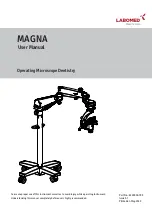
®
Instruction Sheet
012-12002A
PASCO Rotational Inertia Wands
ME-9847
*012-12002*
Introduction
The ME-9847 PASCO Rotational Inertia Wands are designed to show how the distribution of mass in an object
determines the object’s rotationa inertia (moment of inertia). The blue inertia wand has masses installed at both
ends of the tube. The red inertia wand has masses installed near the grip at the center of the wand. Both wands
have the same amount of mass, so they weigh the same and “feel” equally heavy when lifted.
Theory
Objects that can rotate have a tendency to resist any change in their rotation. If they are at rest, they tend to stay
at rest. If they are in motion (rotating), they tend to stay in motion. This tendency is called
rotational inertia
(or
moment of inertia). If a net torque (twisting force) is applied to an object that can rotate, it will change the rota-
tion of the object. The amount of change in the rotation (called the angular acceleration,
) is directly propor-
tional to the net torque,
, and inversely proportional to the rotational inertia,
I
.
The rotational inertia depends on the amount of mass in the object and the distribution of mass. If the mass of an
object is close to its center of rotation, the rotational inertia will be smaller. It will be ‘easier’ to start rotating and
stop rotating the object. If the mass is distributed far away from the object’s center of rotation, the rotational iner-
tia will be larger. It will be ‘harder’ to start rotating and stop rotating the object.
Included Equipment
Rotational Inertia Wand, Blue
Rotational Inertia Wand, Red
Grip area
Grip area
I
--
=




















